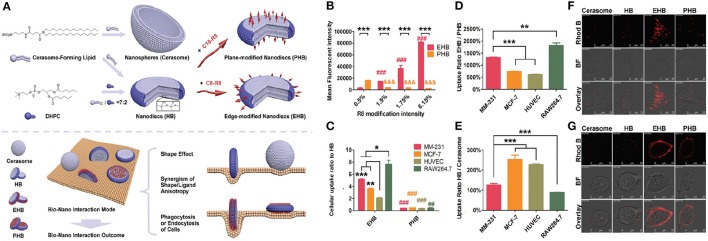Figure 5.
(A) Schematic illustration of engineering, structure, and shape of cerasome, HB, EHB, and PHB, respectively, as well as the manipulation of biological features by the anisotropy in shape and ligand modification through modulating the bio-nano interaction mode. (B) Cellular uptake of EHB and PHB with different R8 modification densities by flow cytometry in MM-231. Completely opposite changes on the cellular uptake were observed with the increase of R8 modification density, which was ascribed to the anisotropic modification of EHB and PHB. n = 3, ***p < 0.001, ###, &&&p < 0.001 vs. 0.5% group. (C) The cell uptake of EHB and PHB compared to HB on different cell lines. All the cell lines showed increased EHB internalization and decreased PHB endocytosis compared with HB, and the anisotropic modification on bicelles changed the output of their biointeraction. n = 3, *p < 0.05, **p < 0.01, ***p < 0.001; ##p < 0.01, ###p < 0.001 vs. EHB group. (D) The cell uptake of EHB compared to PHB on different cell lines. Different cell lines showed distinct EHB/PHB uptake rates, which was consistent with their different phagocytic or endocytic functions. n = 3, **p < 0.01, ***p < 0.001. (E) The cell uptake of HB compared to cerasome on different cell lines. Shape anisotropy and cell natures both affected the internalization of nanoparticulates. n = 3, ***p < 0.001. Cellular uptake/adhesion of Rhod B-labeled HB, EHB, and PHB by MM-231 observed using CLSM at (F) 37°C and (G) 4°C. The internalization was proved to be an energy-dependent process.

